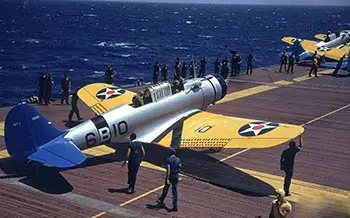World War II Aircraft Carriers
An aircraft carrier serves many functions during war. Think of it as a floating city where planes can depart from, supplies can be moved from, and service men and women can be relocated from in time of need, and planes can land. The Cambridge Dictionary defines an aircraft carrier as, “ a large ship that carries military aircraft and has a long, flat surface where they can take off and land.”
Most aircraft during World War II could hold only a small amount of fuel; so flying to the place where they were needed was not always practical. A carrier could take the planes much closer to the site of battle.
The History of the Aircraft Carrier
The first aircraft carrier to begin to be constructed was the HMS Hermes for the British Navy. This began in 1918. However, it was not commissioned, sent out for work, until February of 1924. The Japanese had begun to build the carrier known as Hōshō in 1919, but it was actually commissioned in December of 1922. So the Hosho is thought of as the very first aircraft carrier.
By 1941 Japan was operating the largest amount of carriers with nine in use. The biggest Japanese aircraft carriers were called the Kaga and Akagi, and they could hold up to 90 planes.


Changes in World War II Aircraft Carriers and Pearl Harbor
The Allies were in possession of some very fine aircraft carriers. British carriers like the Ark Royal, and large carriers from the U.S., such as the Enterprise, could move up to 100 planes on their decks .The largest aircraft carriers, such as the Enterprise were over 245 meters long and 30 meters wide, and transported an amazing 1000-crew member.
The impact that an aircraft carrier could make was first noticed after the Pearl Harbor attack by the Japanese. Japanese carriers had brought in the hundreds of planes by carrier, where they then took off to bomb Pearl Harbor. The six carriers: Akagi, Kaga, Sōryū, Hiryū, Shōkaku, and Zuikaku brought 408 airplanes to an area northwest of Hawaii for the take off from the six carriers and then the attack.
Carriers were usually escorted to where they were needed by Destroyers. The Carriers often moved slowly and could be a good target for the enemy, so the Destroyers and sometimes Battleships were able to protect them.
The amount of planes and men that could be carried increased with World War II as the vessels were built larger and larger. The airplane wings were then designed to fold up, so that more planes could be put on the carrier. The Allies and the AXIS increased the amount of carriers in their respective navy. The United States had 36 carriers during the war, the Royal Navy had 24, the French had one, the Japanese had over 40, and Germany had one named the KMS Graf Zeppelin.


The KMS Graf Zeppelin
The interesting thing about the KMS Graf Zeppelin was that it was never finished being built completely. Hitler had promised the German Navy carriers for the year 1935, and so the keel was laid for the Graf Zeppelin on December 26, 1936. The Graf Zeppelin was 920 feet long and weighed 19,250 tons. Her top speed was to be 33.8 knots. Her crew numbered 1,760 and she was to be able to transport 40 aircraft.

Landing and Taking Off from a Carrier
No matter how large the carrier was in size, the airplane did not have a lot of room for its takeoff. The plane had to get to a certain speed for take off, or it would fall into the ocean. The carriers used what was called a catapult. It looked like a giant slingshot. The plane was projected into the air by the catapult and then flew off.
Landing a plane on a carrier could be hard to do, as well. Each of the airplanes had a hook on the tail. Across the plane a heavy and strong wire was hung. It is called the arresting gear. As the plane landed, the pilot would make sure the plane was placed where the tail hook could catch onto the wire. This was not easy to do, and the pilot had to be very careful.

Planes on a Carrier
There were three different types of planes that took off and that landed on an aircraft carrier during World War II.
1. Fighter– The main job of a Fighter Plane was to protect the Carrier from enemy attacking bombers and to defend and protect the carrier’s bombers from other fighter planes. The Fighter was like the Battleship or Destroyer when it came to protection, but in the air.
2. Dive Bomber- These planes transported bombs that would be dropped on an enemy ship or selected target. They soared up high in the sky and then quickly dove straight down like a bird and released a bomb on the target.
3. Torpedo Bomber – Torpedo bombers carried a torpedo that would be released into the water to try and sink another carrier or enemy warship.




